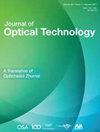Measurement of the refractive index using a goniometric system in an automated mode
IF 0.5
4区 物理与天体物理
Q4 OPTICS
引用次数: 1
Abstract
Subject of study. A method for the measurement of the refractive index using an automated autocollimating goniometric system is proposed. Aim of study. The study facilitates the precise measurement of the refractive indices of transparent solid and liquid optical materials. Method. Goniometric methods based on the measurement of angles of light refraction caused by a substance are often used to measure the refractive indices of trihedral prisms. A method to determine the refractive index via measuring the light deviation angle caused by a prism after reflection from the internal facet in the automated mode is proposed. Main results. The refractive indices of two trihedral prisms composed of different glass types, namely, N-BK7 and SF-1, measured using the proposed method and autocollimating goniometric system are presented. The measurement error did not exceed 1.5×10−4 when compared with the nominal value for these prisms at the wavelength of the radiation source of the autocollimator, thus confirming the prospect of application of this method in high-precision refractive index measurements. Practical significance. The method proposed in this study can be used to measure the refractive indices of trihedral prisms made of optically transparent materials with different apex angles using the goniometric system in an automated mode. The method can also be applied to optically transparent liquid materials located in a hollow trihedral prism.在自动模式下使用角度测量系统测量折射率
研究主题。提出了一种利用自动自准直测角系统测量折射率的方法。研究目的。该研究有助于精确测量透明固体和液体光学材料的折射率。方法。测量三面棱镜的折射率,通常采用测量物质引起的光折射角的角度学方法。提出了一种在自动模式下,通过测量棱镜从内侧面反射后产生的光偏角来确定折射率的方法。主要的结果。用该方法和自准直测角系统测量了N-BK7和SF-1两种不同玻璃类型的三面棱镜的折射率。与这些棱镜在自准直器辐射源波长处的标称测量值相比,测量误差不超过1.5×10−4,从而证实了该方法在高精度折射率测量中的应用前景。现实意义。本文提出的方法可以在自动模式下使用测角系统测量不同顶点角的透明材料制成的三面棱镜的折射率。该方法也可应用于位于中空三面棱镜内的光学透明液体材料。
本文章由计算机程序翻译,如有差异,请以英文原文为准。
求助全文
约1分钟内获得全文
求助全文
来源期刊
CiteScore
0.90
自引率
25.00%
发文量
66
审稿时长
3-8 weeks
期刊介绍:
The journal publishes design details of a diversity of optical instruments, along with a strong section on computational optics useful to engineers, mathematicians, and physicists, as well as optical scientists. Issues of the English translation volume are published by OSA and appear at the same time as the Russian language edition, Opticheskii Zhurnal, which is produced by the Vavilov State Optical Institute

 求助内容:
求助内容: 应助结果提醒方式:
应助结果提醒方式:


